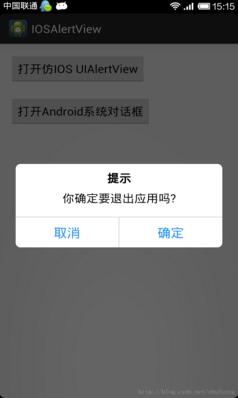本文实例为大家分享了Android仿IOS UIAlertView对话框的具体代码,供大家参考,具体内容如下
显示效果:

我在参考链接中看到了作者的仿的qq提示框,但是在使用的时候并不是很方面,有一些不足,于是我参照Android系统AlertDialog,使用参考链接中的布局文件和style文件,用自己的方法自定义了一下这个仿IOS上面UIAlertView的效果,这样的话让我们可以想使用系统AlertDialog一样使用我自定义的CustomDialog。
CustomDialog使用代码:
package com.example.iosalertview; import android.app.Activity; import android.app.AlertDialog; import android.os.Bundle; import android.view.View; import android.view.View.OnClickListener; import android.widget.Button; import com.example.iosalertview.CustomDialog.Builder; public class MainActivity extends Activity implements OnClickListener{ private Button ios_dialog_btn,android_dialog_btn; @Override protected void onCreate(Bundle savedInstanceState) { super.onCreate(savedInstanceState); setContentView(R.layout.activity_main); ios_dialog_btn = (Button) findViewById(R.id.ios_dialog_btn); android_dialog_btn = (Button) findViewById(R.id.android_dialog_btn); ios_dialog_btn.setOnClickListener(this); android_dialog_btn.setOnClickListener(this); } @Override public void onClick(View v) { switch (v.getId()) { case R.id.ios_dialog_btn: CustomDialog.Builder builder = new Builder(MainActivity.this); builder.setTitle(R.string.prompt); builder.setMessage(R.string.exit_app); builder.setPositiveButton(R.string.confirm, null); builder.setNegativeButton(R.string.cancel, null); builder.create().show(); break; case R.id.android_dialog_btn: AlertDialog.Builder mbuilder = new AlertDialog.Builder(MainActivity.this); mbuilder.setTitle(R.string.prompt); mbuilder.setMessage(R.string.exit_app); mbuilder.setPositiveButton(R.string.confirm, null); mbuilder.setNegativeButton(R.string.cancel, null); mbuilder.create().show(); break; default: break; } } } 自定义CustomDialog代码:
package com.example.iosalertview; import android.app.Dialog; import android.content.Context; import android.content.DialogInterface; import android.view.LayoutInflater; import android.view.View; import android.view.ViewGroup.LayoutParams; import android.widget.Button; import android.widget.LinearLayout; import android.widget.TextView; public class CustomDialog extends Dialog { public CustomDialog(Context context) { super(context); } public CustomDialog(Context context, int theme) { super(context, theme); } public static class Builder { private Context context; //上下文对象 private String title; //对话框标题 private String message; //对话框内容 private String confirm_btnText; //按钮名称“确定” private String cancel_btnText; //按钮名称“取消” private View contentView; //对话框中间加载的其他布局界面 /*按钮坚挺事件*/ private DialogInterface.OnClickListener confirm_btnClickListener; private DialogInterface.OnClickListener cancel_btnClickListener; public Builder(Context context) { this.context = context; } /*设置对话框信息*/ public Builder setMessage(String message) { this.message = message; return this; } /** * Set the Dialog message from resource * * @param title * @return */ public Builder setMessage(int message) { this.message = (String) context.getText(message); return this; } /** * Set the Dialog title from resource * * @param title * @return */ public Builder setTitle(int title) { this.title = (String) context.getText(title); return this; } /** * Set the Dialog title from String * * @param title * @return */ public Builder setTitle(String title) { this.title = title; return this; } /** * 设置对话框界面 * @param v View * @return */ public Builder setContentView(View v) { this.contentView = v; return this; } /** * Set the positive button resource and it's listener * * @param confirm_btnText * @return */ public Builder setPositiveButton(int confirm_btnText, DialogInterface.OnClickListener listener) { this.confirm_btnText = (String) context .getText(confirm_btnText); this.confirm_btnClickListener = listener; return this; } /** * Set the positive button and it's listener * * @param confirm_btnText * @return */ public Builder setPositiveButton(String confirm_btnText, DialogInterface.OnClickListener listener) { this.confirm_btnText = confirm_btnText; this.confirm_btnClickListener = listener; return this; } /** * Set the negative button resource and it's listener * * @param confirm_btnText * @return */ public Builder setNegativeButton(int cancel_btnText, DialogInterface.OnClickListener listener) { this.cancel_btnText = (String) context .getText(cancel_btnText); this.cancel_btnClickListener = listener; return this; } /** * Set the negative button and it's listener * * @param confirm_btnText * @return */ public Builder setNegativeButton(String cancel_btnText, DialogInterface.OnClickListener listener) { this.cancel_btnText = cancel_btnText; this.cancel_btnClickListener = listener; return this; } public CustomDialog create() { LayoutInflater inflater = (LayoutInflater) context .getSystemService(Context.LAYOUT_INFLATER_SERVICE); // instantiate the dialog with the custom Theme final CustomDialog dialog = new CustomDialog(context, R.style.mystyle); View layout = inflater.inflate(R.layout.customdialog, null); dialog.addContentView(layout, new LayoutParams( LayoutParams.MATCH_PARENT, LayoutParams.WRAP_CONTENT)); // set the dialog title ((TextView) layout.findViewById(R.id.title)).setText(title); ((TextView) layout.findViewById(R.id.title)).getPaint().setFakeBoldText(true);; // set the confirm button if (confirm_btnText != null) { ((Button) layout.findViewById(R.id.confirm_btn)) .setText(confirm_btnText); if (confirm_btnClickListener != null) { ((Button) layout.findViewById(R.id.confirm_btn)) .setOnClickListener(new View.OnClickListener() { public void onClick(View v) { confirm_btnClickListener.onClick(dialog, DialogInterface.BUTTON_POSITIVE); } }); } } else { // if no confirm button just set the visibility to GONE layout.findViewById(R.id.confirm_btn).setVisibility( View.GONE); } // set the cancel button if (cancel_btnText != null) { ((Button) layout.findViewById(R.id.cancel_btn)) .setText(cancel_btnText); if (cancel_btnClickListener != null) { ((Button) layout.findViewById(R.id.cancel_btn)) .setOnClickListener(new View.OnClickListener() { public void onClick(View v) { cancel_btnClickListener.onClick(dialog, DialogInterface.BUTTON_NEGATIVE); } }); } } else { // if no confirm button just set the visibility to GONE layout.findViewById(R.id.cancel_btn).setVisibility( View.GONE); } // set the content message if (message != null) { ((TextView) layout.findViewById(R.id.message)).setText(message); } else if (contentView != null) { // if no message set // add the contentView to the dialog body ((LinearLayout) layout.findViewById(R.id.message)) .removeAllViews(); ((LinearLayout) layout.findViewById(R.id.message)).addView( contentView, new LayoutParams( LayoutParams.WRAP_CONTENT, LayoutParams.WRAP_CONTENT)); } dialog.setContentView(layout); return dialog; } } } demo下载地址:Android仿IOS UIAlertView对话框
以上就是本文的全部内容,希望对大家的学习有所帮助,也希望大家多多支持VEVB武林网。
注:相关教程知识阅读请移步到Android开发频道。